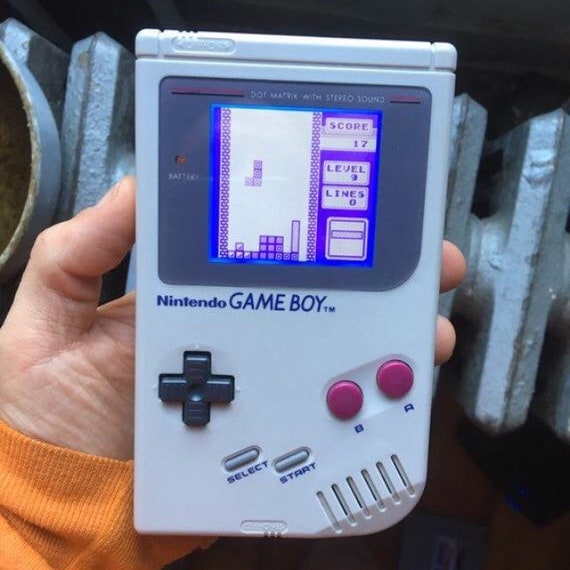

Carefully lift the screen to reveal two small pads underneath. There is a notch for a flat head screw driver. Let dry. Next, on the front PCB, remove the two small screws that attach the screen ribbon cable to the front PCB. If you are repairing vertical lines in the LCD, please see this instruction page. Now lift the glass LCD at the top. Now is a good time to clean the front shell with soap and water. NOTE : These screws are easily stripped, so be careful when removing. Again, keep these in a safe spot they are easy to lose. Proceed to remove the 10 Phillips head screws connecting the front PCB (with the screen) to the front shell.

Next, remove the ribbon cable connecting the front PCB to the back PCB in a gentle downwards motion. At this point you should have the front and the back unit’s separated. Keep these in a safe place as you will need them later when reassembling. To begin, remove all 6 tri-wing screws from the back of your original Game Boy DMG-01. It is always a good idea to disassemble and scrub the plastic casing and clean the front and back PCBs to avoid drying time lost to mother nature. It is especially necessary for the colors red and orange and gameplay can be effected if the resistor is not installed.This backlight allows you to illuminate your old Game Boy for retro gaming in the dark! Make sure to have all of your materials prepared and ready to go before you begin. A resistor is recommended in order to meet the exact voltage recommendations for the LEDs inside.
#Dmg backlight install#
Install the resistor provided to the "+" or red wire and add some heat shrink tubing for extra protection. Use red for the positive "+" pad and blue for the negative "-" pad.

Next, solder the 2 provided wires onto their respective pads on the flat cable of the backlight. The bivert chips will invert your pixels***

***When installing a bivert chip, you'll want to turn your film 90 degrees (clear when up to an LCD) to obtain a normal configuration. Turn the film 90 degrees and your display will invert, what once was dark would become light and vice versa. This orientation will allow for a normal pixel orientation when installing the backlight alone. Orient the film so that it becomes dark when in front of an LCD and then you are ready to place it on top of the backlight to prepare for insertion. Hold up the film to an LCD (such as a monitor) and observe how the transparency of the film changes when you rotate it. You'll want to orient your polarization film properly before you install and close up your case or you'll be opening her up again to turn it 90 degrees. Next, remove the films from the polarized film provided in your kit (front and back). Prepare your LED backlight by removing the protective film on the front. Any speck of dust will give you an annoying dot that is not easily removed. Be sure not to get chemicals on the ribbon cable to avoid damage.***Ĭlean behind your LCD screen with a can of compressed air. You won't scratch your LCD unless you apply uneven pressure. To remove, use a good-remover with a razor blade and gently scrape the glue off. My experiences have revealed that about 1 in 10 game boys have this kind of adhesive. *** If a super sticky layer of adhesive is left over after you remove the film, you will have to put a little more effort in to remove it. Use rubbing alcohol and a cue-tip to remove and clean the glass on the back side of the LCD. Once all of the film has been removed, you may notice a small amount of adhesive in the corners. Severing these could lead to a screen that is not repairable. Make sure to hold the screen with your other hand and protect the connections from the ribbons cables to the LCD. DO NOT pull without securing the LCD screen. Now use your fingers or pliers to peel back the silver film. There is a layer of adhesive under the polarizer that you are aiming to remove as well so be sure to put pressure under, and as close to the glass as possible. Push your blade gently and evenly with pressure about 0.5 inches between the film and LCD. Starting with the top right corner (when lying down) insert the edge of the blade between the silver polarized adhesive film and the glass LCD. Turn the screen front side facing down and obtain a clean, sharp utility blade. To remove the polarized film on the underside of the LCD, protect the front of the screen with tape or a Post-it® note.


 0 kommentar(er)
0 kommentar(er)
